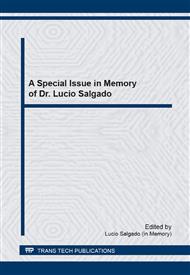p.3
p.7
p.12
p.19
p.26
p.30
p.35
p.41
Nitinol Alloys - Study of Physical and Chemical Application as Biomaterials
Abstract:
The Nitinol is a term which represents the family of nickel and titanium alloys. With the discovery of the extraordinary biocompatibility of these alloys, their implementation has been emphasized in the medical devices and in general dentistry. The characteristics which make these alloys are of interest its superelasticity, shape memory effect and excellent biocompatibility, the latter two characteristics particularly interesting due to the fact that these materials confer the ability to self-expansion or contraction and not presenting rejection the organism. Thus, this study aims to evaluate three NiTi alloys compositions, being one rich in titanium, other poor and the last equiatomic, through tests of physical characterization and surface tension, after different heat treatments. After the results interpretation, it can be seen that the lower percentages by weight of nickel in their products from corrosion was the Nitinol rich in titanium subjected to heat treatment for 24 hours in the oven. Moreover, the same composition present the smallest angle in the test of surface tension.
Info:
Periodical:
Pages:
3-6
Citation:
Online since:
September 2014
Keywords:
Price:
Сopyright:
© 2015 Trans Tech Publications Ltd. All Rights Reserved
Share:
Citation:


